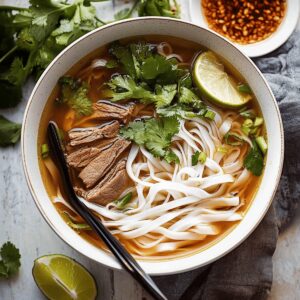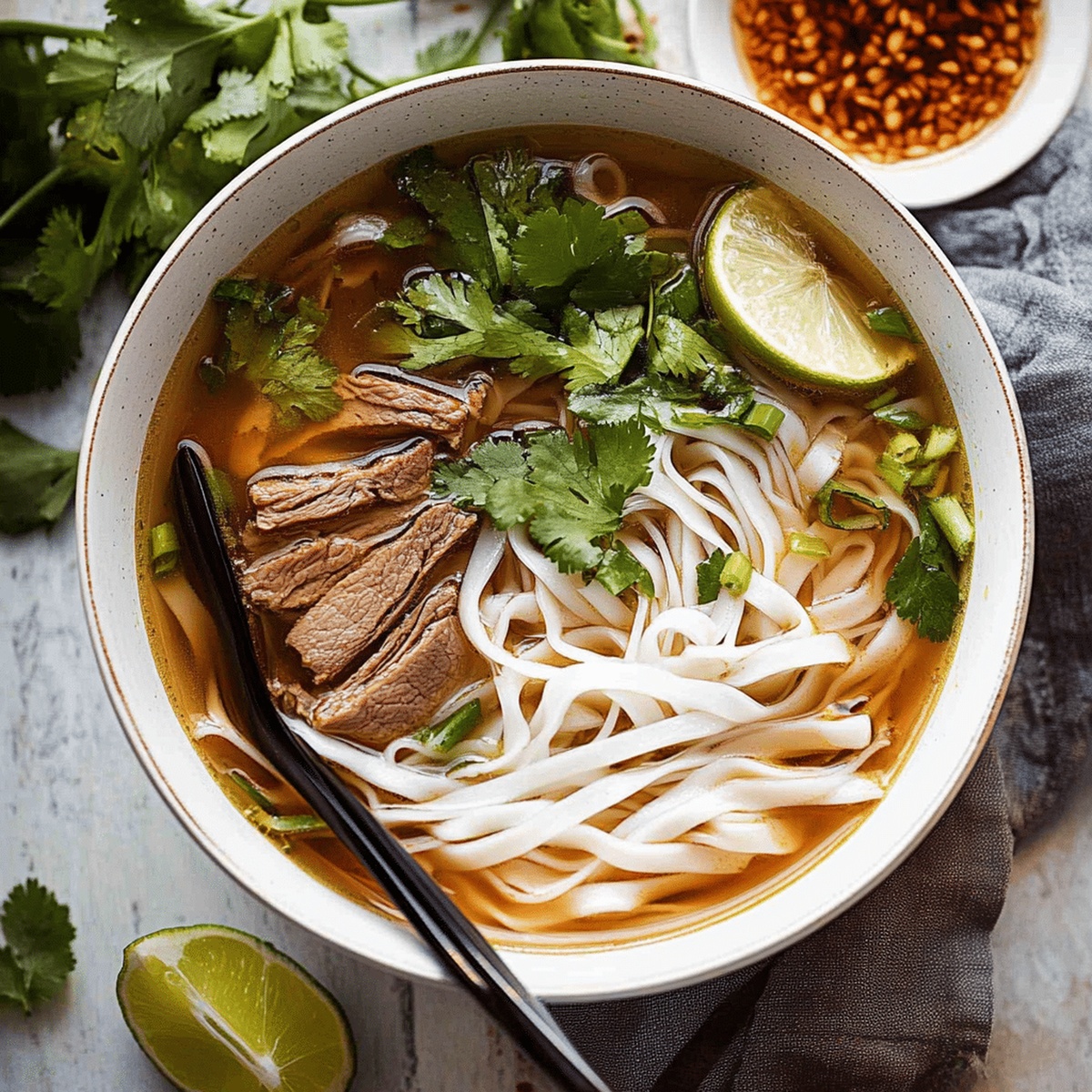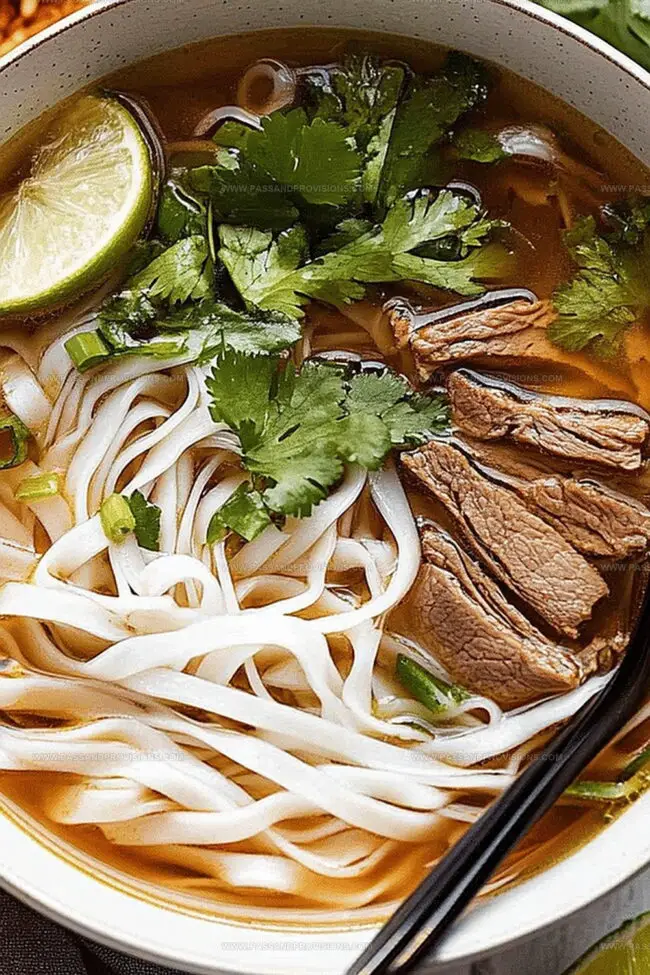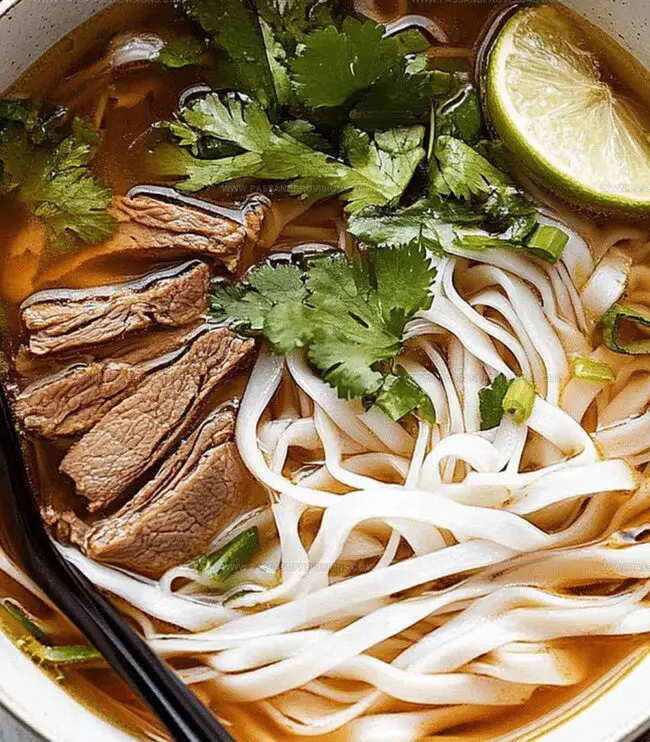Vietnamese Noodle Soup Pho Recipe for Soulful Warmth
Slurping a steaming bowl of vietnamese noodle soup brings pure comfort on chilly evenings.
Aromatic herbs and tender meat dance together in this classic broth.
Fragrant spices whisper stories of hanoi’s bustling streets and culinary traditions.
Memories of street vendors and simmering pots flood back with each spoonful.
Regional variations add depth to this beloved national dish that connects generations.
Rich, complex flavors tell a tale of cultural resilience and passion.
You’ll want to savor every moment of this soul-warming experience.
Why You’ll Love Vietnamese Noodle Soup (Pho)
Ingredients for Vietnamese Noodle Soup (Pho)
Aromatic Base:Protein Components:Soup Liquid and Seasonings:Garnish and Serving Components:How to Prepare Vietnamese Noodle Soup (Pho)
Step 1: Fire Up the Aromatics
Prepare these ingredients:Char the onion and ginger using one of these methods:Rotate the ingredients until they develop a slight black char on the exterior. This technique caramelizes the surface and intensifies their natural flavors, creating a deep, smoky base for the pho broth.
Tip: Look for a golden-brown to dark brown color with some blackened edges, which indicates optimal flavor development without burning the ingredients completely.
The charring process breaks down the cellular structure of the onion and ginger, releasing essential oils and creating a more complex taste profile that will elevate the entire soup’s character.
Careful rotation is key to ensuring even charring and preventing complete combustion of the vegetables. The goal is to create a roasted, slightly smoky exterior while maintaining the ingredient’s internal moisture and structure.
Use tongs or a long-handled utensil to safely manipulate the onion and ginger during the charring process, protecting your hands from direct heat exposure.
Smart Tips for Vietnamese Noodle Soup (Pho)
How to Save and Reheat Vietnamese Noodle Soup (Pho)
Dishes That Pair with Vietnamese Noodle Soup (Pho)
Vietnamese Noodle Soup (Pho) Variants
Vietnamese Noodle Soup (Pho) FAQs
Rinse the rice noodles in cold water after cooking and toss them gently with a little oil to keep them separated.
Yes, you can prepare the broth up to 3 days in advance and store it in the refrigerator. This allows the flavors to develop more deeply.
Choose cuts like sirloin, flank, or brisket. Slice the beef thinly against the grain for the most tender texture.
Yes, skimming the foam during the initial boiling helps create a clear, clean-tasting broth without cloudiness or impurities.
Print
Vietnamese Noodle Soup Recipe (Pho) Recipe
- Total Time: 1 hour
- Yield: 4 1x
Description
Steaming Vietnamese pho transports diners through Hanoi’s bustling street flavors, blending tender rice noodles with aromatic broth and tender meat. Savory herbs and complex spices create a soul-warming experience that connects culinary tradition with pure comfort.
Ingredients
Protein:
- ½ pound (225 grams) thinly sliced beef (sirloin or flank steak) or chicken breast
- Optional: tofu slices for a vegetarian option
Broth and Spices:
- 4 cups (1 liter) beef or chicken stock
- 4 cups (1 liter) water
- 1 large onion, halved
- 3-inch piece of ginger, sliced
- 1 cinnamon stick
- 3 star anise pods
- 4 whole cloves
- 1 teaspoon coriander seeds
- 1 tablespoon fish sauce
- 1 teaspoon sugar
- Salt to taste
Noodles and Garnishes:
- 8 ounces (225 grams) rice noodles (medium or thin)
- 1 cup bean sprouts
- Fresh herbs: cilantro, Thai basil, and mint leaves
- 1 lime, cut into wedges
- 1 red chili or jalapeno, sliced
- Hoisin sauce and sriracha for serving
Instructions
- Roast whole onions and ginger pieces directly over an open flame or in a dry skillet, rotating occasionally to achieve an even char and release deep, smoky aromatics.
- Prepare the beef bones by thoroughly rinsing under cold water, removing any blood or impurities that might cloud the broth’s clarity.
- Transfer rinsed bones to a large stockpot, cover with cold water, and bring to a rolling boil, skimming off any foam that rises to the surface to ensure a pristine, transparent broth.
- Reduce heat and simmer the bones gently, allowing collagen and marrow to slowly dissolve and create a rich, gelatinous base for the soup.
- Add charred onions, ginger, star anise, cinnamon sticks, cloves, and cardamom pods to the simmering broth, infusing it with complex, warming spices.
- Continue simmering the broth for several hours, periodically checking water levels and maintaining a low, steady temperature to extract maximum flavor.
- Season the broth with fish sauce, salt, and a touch of sugar, tasting and adjusting to achieve a balanced, nuanced profile.
- Prepare rice noodles according to package instructions, ensuring they remain tender yet slightly firm.
- Slice beef cuts thinly, arranging them on a plate near the hot broth for quick cooking.
- Assemble individual serving bowls with cooked noodles, raw beef slices, and fresh herbs like Thai basil, cilantro, and mint.
- Ladle piping hot broth over the noodles and beef, allowing the liquid to gently cook the meat.
- Garnish with bean sprouts, lime wedges, sliced chilis, and additional herbs for a vibrant, personalized presentation.
Notes
- Roasting onions and ginger intensifies their smoky, deep flavors, adding complexity to the broth’s profile.
- Use bones with marrow for a richer, more gelatinous stock that creates an authentic, silky texture.
- Simmer the broth gently and never let it boil to maintain clarity and prevent clouding, ensuring a pristine, transparent liquid.
- Consider preparing the broth a day ahead, as flavors develop and deepen overnight, resulting in a more robust and harmonious taste.
- Prep Time: 15 minutes
- Cook Time: 45 minutes
- Category: Lunch, Dinner
- Method: Grilling
- Cuisine: Vietnamese
Nutrition
- Serving Size: 4
- Calories: 320
- Sugar: 1 g
- Sodium: 850 mg
- Fat: 7 g
- Saturated Fat: 2 g
- Unsaturated Fat: 5 g
- Trans Fat: 0 g
- Carbohydrates: 45 g
- Fiber: 2 g
- Protein: 22 g
- Cholesterol: 60 mg




Jamie Granger
Recipe Developer & Food Writer
Expertise
Education
Culinary Institute of America
Jamie Granger turns ingredients into memories. With her recipes, she brings a fusion-forward flair to every creation.
Her dishes reflect the places she’s explored, the chefs she’s learned from, and the deep connection she has to food as a form of expression.
At Pass and Provision, Jamie develops recipes that balance flavor, health, and beauty, meals that don’t just satisfy your appetite but speak to your curiosity.